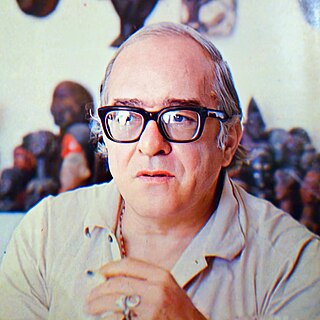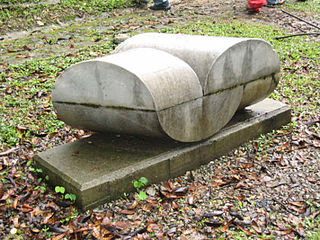Sergio Roberto Santos Rodrigues (September 22, 1927 – September 1, 2014) was a Brazilian carioca architect and designer. Along with Joaquim Tenreiro and José Zanine Caldas, Rodrigues was the pioneer to transform the Brazilian design in industrial design and make it known worldwide. [1] He began his work in the field of architecture in the project of the civic center along with the also architects David Azambuja, Flávio Régis do Nascimento e Olavo redig de Campos.
Carioca is a demonym used to refer to anything related to the City of Rio de Janeiro as well as its eponymous State of Rio de Janeiro, in Brazil. The original word, "kara'i oka", comes from the indigenous Tupi language meaning "house of carijó", which was a native tribe of Rio de Janeiro who lived in the vicinity of the Carioca River, between the neighborhoods of Glória and Flamengo.

Joaquim Tenreiro (1906–1992) was among the leading furniture designers and visual artists in mid-20th century Brazil.
Contents
Had the peak of his career in the 50s and 60s. Worked with furniture design according with the modernism, bringing the Brazilian identity to his projects, both in the design and traditional materials – leather, wood and rattan – exalting the Brazilian and native culture.

Modernism is a philosophical movement that, along with cultural trends and changes, arose from wide-scale and far-reaching transformations in Western society during the late 19th and early 20th centuries. Among the factors that shaped modernism were the development of modern industrial societies and the rapid growth of cities, followed then by reactions of horror to World War I. Modernism also rejected the certainty of Enlightenment thinking, and many modernists rejected religious belief.
“In fact, in this moment he did coexist the Brazilian-Brazil with the Girl-from-Ipanema, sang later (1962) by Tom Jobim and Vinicius de Moraes in the famous "Girl from Ipanema"” (Oscar Niemeyer).

Marcus Vinicius da Cruz e Mello Moraes, also known as Vinícius de Moraes and nicknamed O Poetinha, was a Brazilian poet, lyricist, essayist, and playwright. He served as a diplomat, composed bossa nova music, and recorded several albums.
Contemporary of Oscar Niemeyer and Lúcio Costa, his furniture was utilized in large scale in the construction of Brazil's capital Brasília.

Oscar Ribeiro de Almeida Niemeyer Soares Filho, known as Oscar Niemeyer, was a Brazilian architect considered to be one of the key figures in the development of modern architecture. Niemeyer was best known for his design of civic buildings for Brasília, a planned city that became Brazil's capital in 1960, as well as his collaboration with other architects on the headquarters of the United Nations in New York. His exploration of the aesthetic possibilities of reinforced concrete was highly influential in the late 20th and early 21st centuries.

Lúcio Marçal Ferreira Ribeiro Lima Costa was a Brazilian architect and urban planner, best known for his plan for Brasília.

Brasília is the federal capital of Brazil and seat of government of the Federal District. The city is located atop the Brazilian highlands in the country's center-western region. It was founded on April 21, 1960, to serve as the new national capital. Brasília is estimated to be Brazil's 3rd most populous city. Among major Latin American cities, Brasília has the highest GDP per capita.
“In that time (begin of Brasília) we didn't have time to think about designing any furniture. We used the furniture from the market, selecting as the Palace wanted. The main designer to whom we selected was Sergio Rodrigues” (Lúcio Costa).
His most famous work in the Sheriff's chair (1957), made in leather and wood, with fit and upholstery innovations that inspired works until today.
“The piece of furniture is not just the shape, not just the material which is made but also something inside it. It's the piece's spirit. It's the Brazilian spirit. It's the Brazilian furniture” (Sergio Rodrigues). He died in 2014 at Rio de Janeiro of liver failure. [2]








